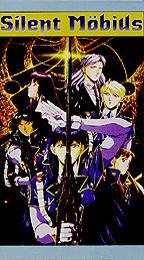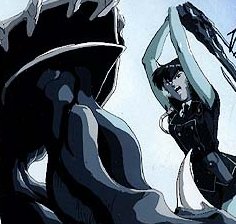Old School
Silent Mobius - Movie
by Mike Crandol,
 Kia Asamiya is no stranger to American comics. The celebrated manga-ka, whose better-known works include Nadesico, Steam Detectives, and Dark Angel, openly acknowledges his style has always been influenced by the great American comic book superheroes. Small wonder Asamiya was tapped to pen the full-length manga debut of Batman, "Child of Dreams." Since relocated to New York, he currently passes his time penciling the monthly adventures of the X-Men for Marvel Comics.
Kia Asamiya is no stranger to American comics. The celebrated manga-ka, whose better-known works include Nadesico, Steam Detectives, and Dark Angel, openly acknowledges his style has always been influenced by the great American comic book superheroes. Small wonder Asamiya was tapped to pen the full-length manga debut of Batman, "Child of Dreams." Since relocated to New York, he currently passes his time penciling the monthly adventures of the X-Men for Marvel Comics.But back in the Land of the Rising Sun Asamiya is best known for a manga series by the unlikely name of "Silent Möbius." This long-running title put its young author on the map back in 1988, and it is here that Asamiya's Western influences are really felt. The familiar good-versus-evil tale blends science fiction and fantasy to tell the story of the AMP ("Attacked Mystification Police"), a team of superpowered individuals who defend a shiny futuristic metropolis from demonic hellspawn known as the Lucifer Hawk. Headed up by the half-human/half-Hawk Rally Cheyenne, the AMP's ranks include a mix of technological and supernatural wonders. The cyborg Kiddy Phenil possesses the strength of ten men, and Lebia Maverick's brain is electronically linked to a satellite that allows her mind to telepathically access computer networks. Shinto priestess Nami calls upon the power of her faith the combat evil, but her magic is nothing next to the AMP's star player Katsumi Liqueur. A literal sorceress, Katsumi's magical powers are inherited from her wizard father, who unwittingly brought the Lucifer Hawk to Earth in the first place.
Though criticized by some for being heavy on action and light on everything else, Silent Möbius' inspired mix of the high-tech and the arcane coupled with Asamiya's beautiful, intricate renderings drew a huge following. Much of the manga's dark, cyberpunk atmosphere owes a debt to Blade Runner, yet its multi-genre storyline recalls the best efforts of Marvel and DC Comics; a postmodern stew of science fiction, fantasy, horror, and tragedy.
All of these disparate elements were successfully transferred to the big screen in 1991 with the release of "Silent Möbius: The Motion Picture." No expense was spared in bringing Asamiya's vivid visions to life, and the movie was easily one of the most opulent productions of the era. Clocking in at a brief 50 minutes, the short running time allowed for more care to be lavished on the film's many action sequences. The result is a perfect animated realization of the gorgeously drawn battles that made the manga so memorable.
The movie is more of a present to fans of the manga than a standalone motion picture. Rather than attempt a condensed retelling of the entire Silent Möbius tale, the movie adapts the "Karma" arc of the manga, which occurs roughly halfway through the series' run. It is also widely acknowledged as a high-watermark of the series and the point at which Asamiya perfected his visual style. Much of the tale is told in flashback; during a particularly nasty Lucifer Hawk attack Katsumi recollects how she was first recruited into the AMP. The audience gets to hear Katsumi's tale from the beginning, but the complex circumstances surrounding the appearance of the Lucifer Hawk as well as the other members of the AMP is never touched upon. As such it serves as a very poor introduction to the Silent Möbius world. But fans of the comic will feel right at home, and even the casual observer should appreciate the high production values and engaging (if somewhat confusing) storyline.

When Lucifer Hawk appear at the site of future Tokyo's Orbital Elevator, the AMP are called into battle. For Katsumi this fight holds special significance. Not only was the Elevator the site of her mother's death, the self-same Hawk who did her in has returned to claim Katsumi. Enlisting the aid of her magical sword Grospoliner, Katsumi confronts her foe as the story flashes back four years prior. Then blissfully unaware of the magic in her blood, Katsumi returns home to Tokyo to visit her sick mother. The Lucifer Hawk sense her presence, however, and seek to use her powers to open a permanent gate between their world, Nemesis, and our own. The AMP intervenes, and after saving her on more than one occasion Katsumi agrees to join their fight. But when a seemingly unstoppable Lucifer Hawk appears it takes the sacrifice of Katsumi's mother to send it back to Nemesis.
Packed with loads of action and atmosphere, the short movie is nonetheless deliberately paced. It never feels rushed, and there is adequate time to establish the film's tense, foreboding mood as well as a proper introduction to its main character. Grueling monster attacks are skillfully balanced against quiet, character-building moments between Katsumi and her mother. Though the credits roll less than an hour after starting the tape, one doesn't feel shortchanged in any way.
Well, almost. This is one movie that definitely leaves its audience clamoring to see more. Those unfamiliar with Asamiya's manga will want to know more about the other characters, who get somewhat slighted by the Katsumi-centric story. We are told next-to-nothing about the other members of the AMP or their abilities. Nami's attire and magic powers suggest her Shinto background, and Kiddy's superstrength hints at her cyborg skeleton, but Lebia's, Rally's, and kid-member Yukie's powers are never even mentioned. But it is the absence of these characters' personalities that hurt the movie the most. The audience not only doesn't get to see what they can do, they don't get to know who they are, and the camaraderie and occasional personality clashes of the manga are notably absent. It is for this reason that the movie is most unfit for Mobius newbies, and fans of the comic will wish they had gotten to see more of the girls in action.
 But Kiddy and Nami do get a little chunk of said action in the opening sequence, which sets the movie's tone and showcases the incredible art and animation that characterize the entire film. The scene is bliss for Mobius manga devotees as Kiddy Phenil emerges from the shadows in full animation, looking like she stepped right out of the pages of the comic. The expertly staged fight that ensues between her, Nami, and a Lucifer Hawk (also brilliantly realized from Asamiya's artwork) looks like a lost scene from Akira with its unusual attention to motion and detail. Things get even better once Katsumi arrives on the scene. Her sword Grospoliner is an impressive piece of work, and as she holds it aloft, summoning her magic to combat the Hawk that killed her mother, the effect is breathtaking. The effects animation brings Katsumi's spellcasting to mind-blowing neon life, and the ensuing confrontation between her and the Hawk is one of the most exciting action setpieces anime has to offer.
But Kiddy and Nami do get a little chunk of said action in the opening sequence, which sets the movie's tone and showcases the incredible art and animation that characterize the entire film. The scene is bliss for Mobius manga devotees as Kiddy Phenil emerges from the shadows in full animation, looking like she stepped right out of the pages of the comic. The expertly staged fight that ensues between her, Nami, and a Lucifer Hawk (also brilliantly realized from Asamiya's artwork) looks like a lost scene from Akira with its unusual attention to motion and detail. Things get even better once Katsumi arrives on the scene. Her sword Grospoliner is an impressive piece of work, and as she holds it aloft, summoning her magic to combat the Hawk that killed her mother, the effect is breathtaking. The effects animation brings Katsumi's spellcasting to mind-blowing neon life, and the ensuing confrontation between her and the Hawk is one of the most exciting action setpieces anime has to offer.Also helping to set the mood is a haunting orchestral score that one might expect to hear accompanying a big-budget Hollywood blockbuster. The slam-bang action scenes need little assistance from the score to make them interesting, but the tense moments leading up to them are greatly enhanced by the spooky music. Dark, shadowy alleyways and creepy abandoned buildings are made doubly menacing by the intense, yet lovely, score. All these later, the Silent Möbius soundtrack remains a hot item among anime music collectors.
Following the success of the film and the continued popularity of the manga, a sequel was produced in 1992. Also featuring a condensed running time, "Silent Möbius 2" did little more to build upon the ensemble cast and offered nothing new to the franchise; though it maintained the high-production values of its predecessor the sequel was never licensed for American distribution. Silent Möbius returned to anime in 1998 as a 26-episode television series. This allowed the chance to tell the entire story from start to finish, but the show's low-budget art and animation butchered Asamiya's intricate style, and much of the manga's charm was lost in the translation. The original Silent Möbius motion picture remains the best adaptation of Asamiya's work to date.
And it's virtually impossible to find these days. This was one of the very first titles Streamline Pictures brought over in 1993, before they partnered with Orion. Unlike many other of their early releases it was never reissued before the company went belly-up. As such VHS copies are very rare indeed...ever rarer is a double-billing release that paired the film with "Neo-Tokyo." Streamline's dub makes some embarrassing changes to the script - such as referring to Lucifer Hawk as a single individual - but with even bootlegs of the movie hard to come by, the VHS release is the best bet for Silent Möbius fans. Be prepared to pay upwards of $30-50 for a copy. The movie is all but forgotten by much of fandom, and it seems doomed to remain banished in Nemesis - distribution limbo.